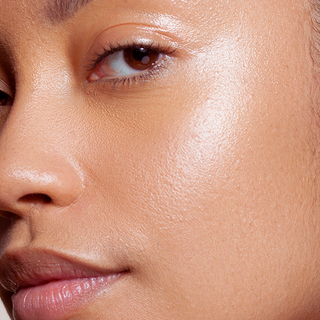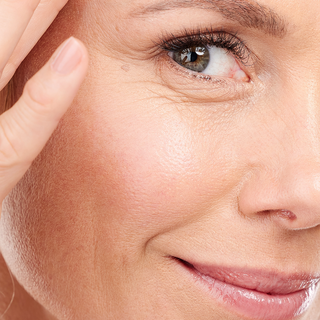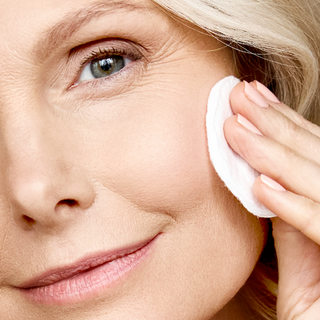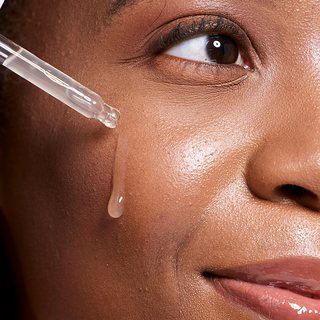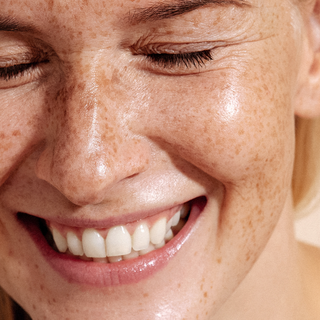Skincare lovers often find themselves staring at their shelf wondering, Can I use all these serums at once? The good news? You can, if you understand how to layer them correctly. In this guide, we’ll break down how to use multiple serums safely and effectively, without the guesswork.
What Are Serums (And Why Are We All Obsessed)?
I like to describe serums as your skin’s “direct line” to transformation. They’re lightweight, fast-absorbing, and made with smaller molecules, so they go where thicker products can’t. That’s why they’re so powerful.
Unlike heavier moisturizers that focus on sealing things in, serums are designed to treat specific concerns at their root, whether it's dehydration, dullness, breakouts, or aging.
Serums 101: What Each Bottle Is Really For
-
Hyaluronic Acid (HA): Your daily hydration MVP. HA draws moisture into the skin like a sponge, plumping fine lines and restoring bounce. It’s my personal go-to in Colorado’s dry climate.
-
Vitamin C: The brightener and protector. This antioxidant powerhouse evens skin tone, fades dark spots, and defends against environmental stressors like pollution and UV damage.
-
Niacinamide: The calming multitasker. It minimizes pores, reduces redness, and strengthens your skin barrier. Think of it as a peacekeeper for stressed-out skin.
-
Peptides: These tiny proteins help build collagen and improve elasticity. If your skin is feeling tired, peptides are like a wake-up call in a bottle.
-
Retinol: The gold standard for cell turnover. Retinol encourages your skin to renew itself faster, which helps reduce the look of wrinkles, breakouts, and uneven tone. It’s powerful, but it requires respect and proper pairing.
-
AHAs/BHAs (like glycolic, lactic, or salicylic acid): These chemical exfoliants help clear pores, smooth texture, and give you that glow-from-within look without physical scrubs.
How Many Serums Can You Actually Use At Once?
More isn’t always better, smarter is. And when it comes to serums, smarter usually means sticking with two to three per routine. That’s your sweet spot.
Why?
Because skin can only absorb so much at one time. Layering five or six serums might feel like you’re covering all your bases, but what often happens is that they sit on the surface, clash with each other, or worse, irritate your skin and throw off your barrier.
Think of it like pouring too much water on dry soil, it just pools at the top.
So yes, you can use multiple serums. But it should be intentional. Each one should serve a unique purpose, complement the others, and be compatible in both texture and chemistry.
💧 Morning Routine Suggestions (AM)
Your daytime routine should be about hydration, protection, and radiance. Here’s how I structure it for clients, and myself.
Step 1: Hydrating Serum
Hyaluronic Acid is your base layer. It plumps, preps, and enhances everything that follows. Apply to damp skin to lock in moisture more effectively.
Check out: Nourishing HA Peptide Serum
Step 2: Brightening or Antioxidant Serum
Vitamin C is my go-to here. It tackles dullness, sun damage, and free radicals. Just make sure you’re using a formula that plays nicely with your HA layer.
Check out: Brightening CE Ferulic Serum
Finish with: Moisturizer + Broad-spectrum SPF. Never, EVER skip the sunscreen, especially if your routine includes actives.
Check out: Barrier Replenishing Cream + Illuminating Beauty Balm SPF 44
🌙 Night Routine Suggestions (PM)
Evenings are all about repair and renewal. Here’s how I recommend structuring your nighttime serum lineup:
Step 1: Hydrating Serum
Start with HA again, hydrated skin is resilient skin. This step also helps cushion the intensity of stronger actives that follow.
Step 2: Active Treatment
This is where you apply your big hitters, Retinol, AHA, or BHA, depending on your skin’s needs. Remember: Don’t use multiple strong actives in one go. Choose one focus per night.
Check out: Overnight Youth Booster
Step 3: Barrier-Repair Serum
Think peptides or niacinamide here. This layer restores balance, soothes potential irritation, and supports your skin’s natural healing overnight.
💡 Pro Tip: If your skin is feeling overloaded, red, or suddenly not responding to your routine like it used to, it might be time to simplify. Over-layering can quietly sabotage progress.
How To Layer Serums Correctly (Without Confusing Your Skin)
Layering serums isn’t just about stacking bottles, it’s about strategy. When you apply the right formulas in the right order, you’re not just pampering your skin, you’re empowering it.
But if you pile them on haphazardly? That’s where irritation, pilling, and wasted product sneak in.
Let me walk you through how I coach my clients (and design my own routines) to make every drop count.
🧪 Golden Rule: Lightest To Thickest
Think of your skin like a sponge, what’s applied first has the best chance to soak in.
Start with water-based serums like hyaluronic acid and work your way up to richer, more emollient textures like peptides or oil-infused formulas. This ensures the deeper-penetrating ingredients get where they need to go, and nothing gets blocked along the way.
⏳ Wait Between Layers (Yes, It Matters)
I know we’re all in a rush sometimes (been there), but serum layering isn’t a race. If you apply too quickly, you risk pilling, when your products roll off like eraser shavings, and you’re not getting the full benefit of the actives.
Wait 30 seconds to 2 minutes between serums, or until each layer feels mostly absorbed but still slightly damp, not bone dry.
✨ Tip from my practice: Go by feel. If your skin still feels slippery or tacky, wait a little longer before layering the next one. Texture is your guide.
🎯 Apply Based On Your Skin’s Priority
Here’s where most people overthink it, but it’s simpler than it sounds:
Apply the serum that treats your biggest concern first. That gives it the most direct path into your skin.
-
Is your skin dehydrated and tight? Start with HA.
-
Battling hyperpigmentation or sun spots? Start with Vitamin C.
-
Focusing on anti-aging? Let Retinol lead your PM lineup.
-
Need barrier repair? Apply your Peptides or Niacinamide closer to the end.
💡 And remember: if you're using a more intensive active (like retinol), layering a hydrating serum underneath (hello MK’s HA Peptide Serum!) can buffer irritation without dulling results.
Layering doesn’t have to be confusing. With a little know-how and a less-is-more mindset, your routine becomes efficient, not overwhelming.
And if you're still unsure where to begin? My line was built to make this simple, with each product designed to pair seamlessly for targeted, layered results.
What Serums Should You Not Mix?
This is where even the most well-intentioned routines can fall apart. You’ve got all the right serums, but if you combine the wrong ones in the same routine?
You could be sabotaging your skin’s progress, and possibly inflaming it in the process.
I see this often with clients who are eager for results and try to layer every “power ingredient” they’ve ever heard of. Trust me, the fastest way to set your skin back is to overload it with actives that don’t play well together.
Here’s your no-fluff cheat sheet to keep your skin safe, clear, and thriving:
🚫 Do Not Mix These Serums (In The Same Routine):
|
✘ Pairing |
Why It’s a Problem |
|
Retinol + AHA/BHA |
This combo is a fast track to over-exfoliation, redness, flaking, and compromised skin barrier. Both are powerful on their own, don’t double up. |
|
Vitamin C (Ascorbic Acid) + Retinol |
Their pH levels clash, which can reduce effectiveness and trigger sensitivity or irritation. |
|
Vitamin C + Niacinamide (older formulations) |
In unstable forms, these two can neutralize each other or trigger flushing, especially on sensitive skin. |
|
Peptides + AHA/BHA or Vitamin C |
Acids can break down peptides, making them less effective. You're not harming your skin, but you are wasting your investment. |
🧠 Pro Insight: Don’t Layer, Alternate Instead
If you want the benefits of multiple actives that don’t get along, you can still use them, just not at the same time. Here’s what I recommend:
-
AM: Go for your brightening + antioxidant duo (Vitamin C + HA), followed by SPF.
-
PM: Bring in your exfoliating or retinol-based treatments, paired with barrier-repair serums or moisturizers.
Need help remembering?
Think C in the day, R at night.
(C = Vitamin C, R = Retinol. Keep them apart for best results!)
Can You Mix Serums? (Cocktailing Vs. Layering)
Ah, the age-old serum question: “Can I just mix them all together and save a step?”
I get this one a lot in client consults. The answer? Yes… but only in certain cases. And it depends on your intention.
There are two ways to apply multiple serums: layering and cocktailing. Both have their place in a smart routine, but knowing when (and how) to use each can mean the difference between glowing skin and wasted product.
🧴 Layering: One By One, With Purpose
Layering means applying each serum individually, in a deliberate order, usually from thinnest to thickest. This method is ideal for active ingredients like retinol, vitamin C, or peptides – where pH, penetration, and where you put it really matter.
Layering allows you to:
-
Target specific concerns with precision
-
Avoid ingredient conflicts
-
Give each serum a moment to absorb and do its job
🧬 Think of it like a skincare symphony, each serum has its solo moment before the next joins in.
🧪 Cocktailing: Time-Saver For Compatible Serums
Cocktailing is when you mix two (sometimes three) serums together in the palm of your hand and apply them as one blend. This is totally fine, if the serums are similar in texture, purpose, and pH.
Cocktailing works best with:
-
Hydrators like hyaluronic acid and peptides
-
Soothing blends with minimal actives
-
Barrier-repair combos (like HA + ceramides)
⚠️ But skip cocktailing with anything strong or pH-sensitive, like vitamin C, retinol, or exfoliating acids. You risk destabilizing the formulas or reducing their effectiveness.
🎯 So, What’s Better?
If you’re pressed for time in the morning? Cocktail your HA and peptides.
If you’re treating hyperpigmentation, breakouts, or fine lines? Layer thoughtfully to avoid diluting your results, or worse, irritating your skin.
In short? Choose your method based on what your skin needs that day. Skincare isn’t rigid, it’s responsive. And the more in tune you are with your skin, the better your serums will perform.
Maria Kane Serums: Can They Be Layered? (Spoiler: Yes, Smartly)
Maria Kane doesn’t just make serums, it formulates systems. Every product in the collection was formulated with layering synergy in mind.
That means you don’t have to guess which serums work together or worry about irritation or ingredient conflict. The answer is yes, you can layer our serums. The key is doing it with intention.
Our entire skincare philosophy centers on this: fewer products, stronger results.
Each formula is minimalist in design but maximal in impact. That’s how we empower your skin to glow, without the noise, confusion, or 12-step fatigue.
Here’s how our bestsellers fit into your routine without skipping a beat:
⭐ Brightening CE Ferulic Serum
Use: Morning
Pair with: Nourishing HA Peptide Serum
Avoid pairing with: Retinol or exfoliating acids in the same routine
This antioxidant-rich formula is your AM hero, protecting against environmental stress, fading sun damage, and brightening your complexion. Layer it after hydration and before SPF.
If your skin goals include tone, radiance, or fighting dark spots, this is your go-to.
Use: AM + PM
Pairs well with: Everything. Seriously.
This is your hydration workhorse. It layers beautifully under every serum in our line and helps buffer stronger actives like retinol. It also strengthens your skin barrier with peptides, making it a smart base for sensitive skin types or those new to layering.
💧 Pro Tip: Apply this to slightly damp skin for deeper moisture infusion, it acts like a sponge, pulling in everything you apply afterward.
⭐ Overnight Youth Booster (Retinol + Niacinamide)
Use: Nighttime only
Pair with: HA Peptide Serum + Barrier Replenishing Cream
Avoid pairing with: Vitamin C or AHAs/BHAs in the same routine
This is your nighttime skin reset. A potent, but buffered, retinol blend designed to stimulate renewal, calm inflammation, and smooth texture without flaking or irritation.
You don’t need to layer additional actives with this, just support it with hydration and repair.
⭐ Clarifying Complexion Serum
Use: AM or PM (based on skin sensitivity)
Pair with: HA Peptide Serum
Avoid pairing with: Retinol or strong acids in the same routine
Formulated with micronized benzoyl peroxide and glycolic acid,, this serum is ideal for oily, breakout-prone, or congested skin. It helps regulate oil, clear blemishes, and reduce redness, all without stripping your barrier.
Use it in place of retinol on nights when your skin needs a gentler reset, or in the morning to keep pores clear throughout the day.
🧖🏼♀️ Tip: This is a great serum to alternate into your routine 2–4x per week if you’re already using retinol.
You’re Not Overreacting, These Skin Concerns Are Totally Valid
Let’s be honest, layering serums can feel like navigating a chemistry lab in your bathroom. I’ve had clients walk into my clinic clutching six different bottles, wide-eyed and overwhelmed, asking, “Am I doing this right?”
And you know what? That’s totally normal.
So if you’re sitting with questions, or even a little product fatigue, you’re not alone. Here’s some clarity, straight from my treatment chair to yours:
What If I Have Facial Hair, Does It Block Absorption?
🧔🏻♂️ Not at all. Light stubble or even short facial hair doesn’t prevent your serums from working. Just focus on massaging them into exposed skin, especially around the cheeks and forehead.
The act of massage also boosts circulation, which helps ingredients penetrate better.
My Skin Gets Red When I Layer, Am I Doing It Wrong?
😬 Possibly. Redness or stinging can be your skin's way of saying "too much, too fast." You might be layering conflicting actives (like retinol + vitamin C) or using too many at once.
Start by introducing one serum at a time, and always patch test new formulas.
If you’re using my Overnight Youth Booster, for example, don’t pair it with exfoliating acids or vitamin C on the same night. Let it shine solo.
I’m Overwhelmed, I Have 6 Serums And Don’t Know Which To Pick.
🤯 I hear this all the time. Don’t try to use them all every day. Instead, pick two per routine:
-
One for hydration (like our HA Peptide Serum),
-
One for your top concern (brightening, smoothing, firming, you name it).
Rotate the rest throughout the week. Skincare doesn’t have to be rigid to be effective, it just needs to be thoughtful.
Don’t Just Layer, Layer With Intention
Layering serums can totally transform your skin, but only if done smartly.
Think of it like building a playlist: more isn’t always better, but the right songs (or serums) in the right order? Game-changer.
✨ Ready to get intentional about your glow?
Let’s build your glow routine. Start with Maria Kane’s core serums, each one is designed to pair


